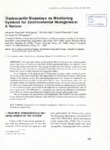Por favor, use este identificador para citar o enlazar este ítem:
http://www.alice.cnptia.embrapa.br/alice/handle/doc/12754Registro completo de metadatos
| Campo DC | Valor | Lengua/Idioma |
|---|---|---|
| dc.contributor.author | RODRIGUES, G. S. | pt_BR |
| dc.contributor.author | MA, T. | pt_BR |
| dc.contributor.author | PIMENTEL, D. | pt_BR |
| dc.contributor.author | WEINSTEIN, L. H. | pt_BR |
| dc.date.accessioned | 2017-03-01T23:44:20Z | - |
| dc.date.available | 2017-03-01T23:44:20Z | - |
| dc.date.created | 1997-10-22 | pt_BR |
| dc.date.issued | 1997 | pt_BR |
| dc.identifier.citation | Critical Reviews in Plant Sciences, v.16, n.4, p.325-359, 1997. | pt_BR |
| dc.identifier.uri | http://www.alice.cnptia.embrapa.br/alice/handle/doc/12754 | pt_BR |
| dc.description | Since the early studies on the genetic effects of chemical and physical agents, species and clones of Tradescantia have been used as experimental subjects, by virtue of a series of favorable genetic characteristics. Bearing just six pairs (2n = 12) of large, easily observable chromosomes, cells from almost every part of the plant, from the root tips to the developing pollen tube, yield excellent material for cytogenetic studies. As a consequence of the intensive use of Tradescantia in genetic studies, a series of genetic characteristics have been found that offer opportunities for the detection of agents affecting the stability of the genome. At least five such characteristics have been selected as endpoints for the establishment of assays to evaluate mutagenesis. Three of these, root-tip mitosis, pollen-tube, and microspore mitosis are essentially chromosome aberration assays, wherein one observes and evaluates the visible damage in the chromosomes. A fourth, the stamen-hair mutation assay (Trad-SHM), is a point mutation mitotic assay based on the expression of a recessive gene for flower color in heterozygous plants. The fifth assay is a cytogenetic test based on the formation of micronuclei (Trad-MCN) that result from chromosome breakage in the meiotic pollen mother cells. This article examines the characteristics and fundamentals of the Trad-MCN and the Trad-SHM assays and reviews the results obtained to date with these systems in the assessment of environmental mutagenesis. | pt_BR |
| dc.language.iso | eng | eng |
| dc.rights | openAccess | eng |
| dc.subject | Bioindicator | pt_BR |
| dc.subject | Atmospheric pollutants | pt_BR |
| dc.subject | Soil contaminants | pt_BR |
| dc.title | Tradescantia bioassays as monitoring systems for environmental mutagenesis: a review. | pt_BR |
| dc.type | Artigo de periódico | pt_BR |
| dc.date.updated | 2017-03-01T23:44:20Z | pt_BR |
| dc.subject.nalthesaurus | genotoxicity | pt_BR |
| dc.subject.nalthesaurus | remediation | pt_BR |
| dc.subject.nalthesaurus | soil amendments | pt_BR |
| dc.subject.nalthesaurus | water pollution | pt_BR |
| riaa.ainfo.id | 12754 | pt_BR |
| riaa.ainfo.lastupdate | 2017-03-01 | pt_BR |
| dc.contributor.institution | GERALDO STACHETTI RODRIGUES, CNPMA; TE-HSIU MA, WESTERN ILLINOIS UNIVERSITY; DAVID PIMENTEL, CORNELL UNIVERSITY/NY; LEONARD H. WEINSTEIN, BOYCE THOMPSON INSTITUTE FOR PLANT RESEARCH/NY. | pt_BR |
| Aparece en las colecciones: | Artigo em periódico indexado (CNPMA)  | |
Ficheros en este ítem:
| Fichero | Descripción | Tamaño | Formato | |
|---|---|---|---|---|
| 1997AP044RodriguesTradescantia3350.pdf | 2,01 MB | Adobe PDF |  Visualizar/Abrir |









